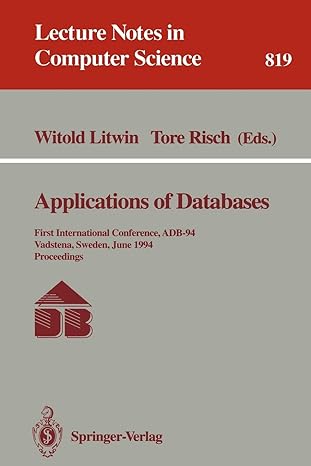Question
1. Write a SELECT statement that uses the GROUP BY ROLLUP clause to return the count of orders for each State and City, with summary
1. Write a SELECT statement that uses the GROUP BY ROLLUP clause to return the count of orders for each State and City, with summary rows for the non-aggregate columns (ROLLUP automatically does this):
The State column from the Addresses table
The City column from the Addresses table
A count of the number of orders
Sort the result set in descending sequence by State, and descending sequence by City.
2. Write a SELECT statement that uses the GROUP BY CUBE clause to return the count of orders for each State and City, with summary rows for the non-aggregate columns (CUBE automatically does this):
The State column from the Addresses table
The City column from the Addresses table
A count of the number of orders Sort the result set in descending sequence by State, and descending sequence by City.
3. Write a SELECT statement that uses the GROUP BY GROUPING SETS clause to return the count of orders for each customer (using concatenation of First and Last name), as well as the count of orders for State and City, with summary rows for the non-aggregate columns (using ROLLUP):
A calculated column with alias Fullname that contains the first and last name of the customer with a space in between first and last name.
The State column from the Addresses table
The City column from the Addresses table
A count of the number of orders
Sort the result set in descending sequence by State, and descending sequence by City.
Make sure the final summary row is in the correct position (this can be adjusted with the order of the items in the GROUPING SET).
4. Write a SELECT statement that uses the OVER clause to return the sum and average of all order items final prices (ItemPrice minus DiscountAmount) and a count of all the order items. Partition the OVER clause by OrderDate from the Orders table for the sum, average, and count. Also include the product name, orderdate, and the final price for each item (without aggregation) using the formula (ItemPrice minus DiscountAmount). The select statement should include the following columns in the order below:
The ProductName column from the Products table.
The OrderDate column from the Orders table.
A calculated column with alias ItemSalesPrice which is calculated as follows: ItemPrice minus the DiscountAmount from the OrderItems table.
OVER clause: sum of the ItemPrice minus the DiscountAmount from the OrderItems table partitioned by the OrderDate from the Orders table. Use alias TotalSalesOnDate for the calculated column.
OVER clause: average of the ItemPrice minus the DiscountAmount from the OrderItems table partitioned by the OrderDate from the Orders table. Use alias AvgSalesOnDate for the calculated column.
OVER clause: count of the ItemPrice from the OrderItems table partitioned by the OrderDate from the Orders table. Use alias TotalItemsSoldOnDate for the calculated column.
Sort the result set in ascending sequence by OrderDate and ProductName.
SQL programming
Step by Step Solution
There are 3 Steps involved in it
Step: 1

Get Instant Access to Expert-Tailored Solutions
See step-by-step solutions with expert insights and AI powered tools for academic success
Step: 2

Step: 3

Ace Your Homework with AI
Get the answers you need in no time with our AI-driven, step-by-step assistance
Get Started


